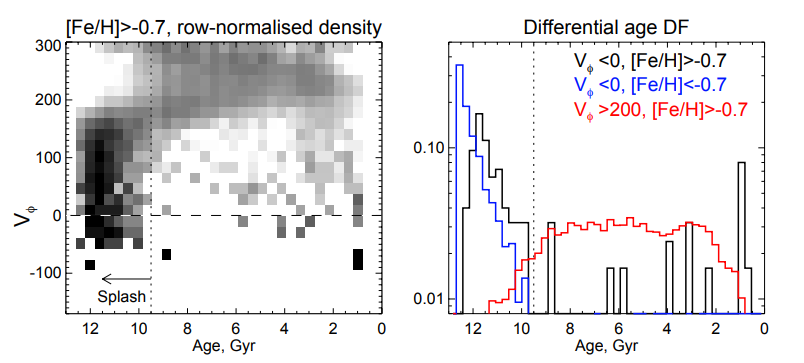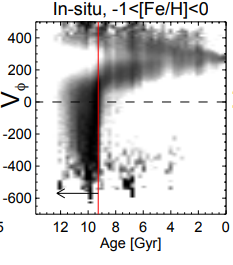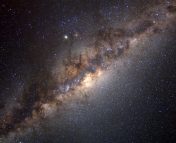Title: The biggest Splash
Authors: Vasily Belokurov, Jason L. Sanders, Azadeh Fattahi, Martin C. Smith, Alis J. Deason, N. Wyn Evans, Robert J. J. Grand
First Author’s Institution: Institute of Astronomy, University of Cambridge, UK
Status: Submitted to MNRAS, open access on arXiv
The Milky Way (MW) has had a relatively quiet and peaceful life. Every now and again a dwarf galaxy comes by and causes a small perturbation, but generally speaking, our galaxy has been left to do its own thing. This has allowed for the formation of a thin stellar disk in which the vast majority of the MW’s stars reside, including the Sun (see Figure 1).

Other galaxies have not been so lucky. Many of them show signs of having gone through a major merger in their recent past — in other words, the galaxy we see today is the result of a catastrophic collision between two galaxies of similar sizes. Major mergers tend to produce puffed up spheroidal or elliptical galaxies, and have far-reaching effects on the structure and the star formation rates within the galaxies. Such a catastrophic collision is actually expected to happen between the MW and our nearest neighbor, Andromeda, but only in approximately four billion years (here’s a great simulation of what that might look like!).
But has the MW always been so isolated? Recent observations suggest otherwise. It appears that the MW did in fact undergo a major merger, approximately ten billion years ago. Today’s paper focuses on the after-effects of this merger, and in particular on a group of stars — referred to as the Splash — whose orbits were dramatically changed as a result of the collision.
The last major merger
Understanding the formation history and the evolution of the MW is one of the central questions in the field of galactic archaeology. Whereas archaeologists study the characteristics of artifacts to glean information about ancient history and culture, galactic archaeologists study the locations, chemical compositions, and ages of stars to try and piece together the historical events that led our galaxy to look like it does today. The field has received a significant boost over the past few years thanks to ESA’s Gaia mission, which provides accurate position and velocity data for over a billion stars in the MW.
The Gaia data revealed a peculiar group of very old (>10 billion years) halo stars on highly radial orbits. In addition, they all have very low metallicities, indicating that they were born in a very metal poor environment unlike the MW (even ten billion years ago the MW was more metal enriched than these stars appear to be). This stellar population is consistent with being the debris from a galaxy that collided head-on with the MW, approximately ten billion years ago. The colliding galaxy has been named both Gaia-Enceladus and the Gaia Sausage, depending on which research group you ask — here I will continue to refer to is as the Sausage following today’s authors.

From a Sausage to a Splash
In today’s paper, we learn that an even more careful evaluation of the MW halo stars reveals two distinct populations on the strange radial trajectories described above. The first, and larger, population is consistent with being composed of the stars that used to make up the Gaia Sausage galaxy before it merged with the MW. The second group, however, has significantly higher metallicities, similar to the lowest-metallicity stars in the MW’s disk.
The authors posit that this second group of stars, which they name the Splash, was initially formed in the MW’s disk, before the collision with the Sausage scattered them to entirely different orbits. The authors proceed to perform a series of tests to confirm this hypothesis.

First, they study the eccentricities and the ages of stars with higher metallicities (-0.7 < Fe/H < -0.2). As shown in Figure 3, the vast majority of stars on radial orbits are at least 9.5 billion years old. This is just like the stars that used to be part of the Gaia Sausage, except that, as mentioned above, these stars’ metallicities are much too high for them to have been born in the Sausage.
Next, the authors compare the ages of the Sausage stars to the Splash stars, and find that while the age cutoff is identical (>9.5 billion years), the Splash stars are on average one billion years younger than their counterparts from the Sausage. The authors explain that this is reasonable given the higher metallicity of these stars and the fact that they were born in the MW’s proto-disk, which would have taken longer to assemble than the Gaia Sausage. This is actually in contrast to the results of another paper that came out earlier this year (and was covered in this astrobite), that found both the Splash stars and the Sausage stars to be of a similar age distribution.

Finally, the authors search MW-like simulations for similar structures in velocity, age, and metallicity space. In both the Auriga and Latte simulations, the authors locate Splash-like structures, and show that they originate from a single major-merger event that happens relatively early on (see Figure 4 for an example).
Though our galaxy has had nearly ten billion years to recover from this collision, its after-effects are still all around us. To quote the last line from today’s paper, “The Milky Way never looked the same after the Biggest Splash.”




